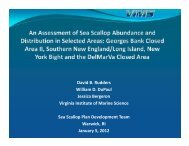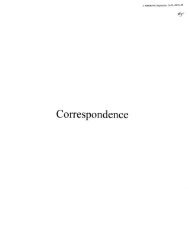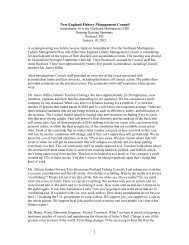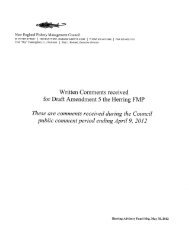Smooth Bottom Net Trawl Fishing Gear Effect on - New England ...
Smooth Bottom Net Trawl Fishing Gear Effect on - New England ...
Smooth Bottom Net Trawl Fishing Gear Effect on - New England ...
You also want an ePaper? Increase the reach of your titles
YUMPU automatically turns print PDFs into web optimized ePapers that Google loves.
NOAA/NMFS Unallied Science Project, Cooperative Agreement NA16FL2264 December 2005<br />
<str<strong>on</strong>g>Smooth</str<strong>on</strong>g> <str<strong>on</strong>g>Bottom</str<strong>on</strong>g> <str<strong>on</strong>g>Net</str<strong>on</strong>g> <str<strong>on</strong>g>Trawl</str<strong>on</strong>g> <str<strong>on</strong>g>Fishing</str<strong>on</strong>g> <str<strong>on</strong>g>Gear</str<strong>on</strong>g> <str<strong>on</strong>g>Effect</str<strong>on</strong>g> <strong>on</strong> the Seabed:<br />
Investigati<strong>on</strong> of Temporal and Cumulative <str<strong>on</strong>g>Effect</str<strong>on</strong>g>s BKAM/CR<br />
water column. The beginning of this fall mixing can be seen in the October CTD data.<br />
Mixing is then complete in November, most likely due to the storm.<br />
Rock crab catch and densities at Little Tow were very similar to those for Mud Hole<br />
rising slightly from August to October then falling off in November. M<strong>on</strong>kfish were <strong>on</strong>ly<br />
present at a significant density in August at Little Tow, Lane 1 (2.57 kg/1000m 2 ) then<br />
decline sharply to 0.23kg/1000m 2 in October, and were not present in November.<br />
In August 2002, Little Tow stati<strong>on</strong> densities for spiny dogfish were slightly higher than<br />
those seen at Mud Hole but dropped to almost zero in October and stayed low through<br />
November.<br />
3.6.2 Flatfish Metrics and Stomach C<strong>on</strong>tent Results<br />
Refer to Figures 3.6-8 to 3.6-11 for length frequency distributi<strong>on</strong>s for yellowtail flounder<br />
and winter flounder at Mud Hole and Little Tow. The yellowtail and winter flounder<br />
catch ranged from 16 to 41 cm in length. The length frequency distributi<strong>on</strong> of yellowtail<br />
flounder indicate that the catch was dominated by an age class of two-year-old fish with a<br />
mean size of about 33 cm in August, increasing to 34 cm in November. This increase<br />
shows growth over the study period. A few <strong>on</strong>e- and three-year-old fish are present as<br />
well (NOAA-NMFS EFH source documents). Winter flounder showed a similar shift<br />
from about 9 cm to almost 33 cm, again showing dominance of a sec<strong>on</strong>d year age class.<br />
The purpose of assessing the stomach c<strong>on</strong>tents of the targeted bottom feeding fish, winter<br />
flounder and yellowtail flounder, was to:<br />
Document the diets of these flatfish within the study sites c<strong>on</strong>sidered Essential<br />
Fish Habitat (EFH);<br />
Determine how the flatfish prey selecti<strong>on</strong> may relate to the benthic fauna; and<br />
Explore the potential effects of repeated towing <strong>on</strong> c<strong>on</strong>sumpti<strong>on</strong> or diet.<br />
Feeding by yellowtail flounder is generally restricted to benthic macrofauna. Annelids<br />
and arthropods found <strong>on</strong> the sediment surface c<strong>on</strong>stitute large comp<strong>on</strong>ents of the<br />
yellowtail flounder diet. For yellowtail flounder above 5 cm in length, other invertebrates<br />
and fish (e.g., capelin and sand lance) make up most of the remainder. Am<strong>on</strong>g<br />
crustaceans, amphipods are the largest diet comp<strong>on</strong>ent.<br />
Winter flounder are generalists that feed <strong>on</strong> any prey of suitable size encountered while<br />
foraging. Adults have little variati<strong>on</strong> in diet with size. Mouth size is even more restrictive<br />
than in yellowtail. Polychaetes, crustaceans (amphipods and decapods) and mollusks<br />
(bivalves) are identified as important prey by percent incidence and weight for studies in<br />
the Gulf of Maine. Polychaetes were frequently the most important food item <strong>on</strong> a<br />
percent weight basis and in terms of numbers (Langt<strong>on</strong> and Bowman 1981). Cnidaria<br />
have also been found to be an important comp<strong>on</strong>ent of the adult winter flounder diet<br />
59







